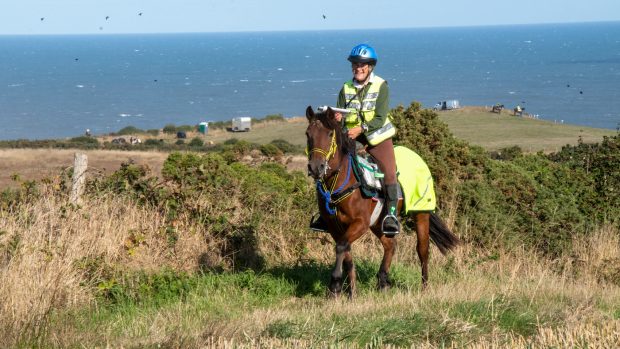With an emphasis on horsemanship rather than horse power, TREC offers riders an interesting but relatively safe competitive challenge.
How did it all begin?
TREC originated in France, where it developed as a means of testing and improving the skills of trail ride leaders in the equestrian tourism industry.
It was introduced to the UK in the 1990s and remains a sport based on the skills required for hacking.
What is TREC?
The 3-phase sport tests rider navigation and the horse’s ability to tackle different terrain and natural obstacles, without undue demands on either bravery or bank balance.
“You can be as competitive as you like,” says Amanda Marfleet of TREC GB. “It’s a sport in which you have to use
your head — it’s really a mind game.”
How does it work?
There are 4 competitive levels in TREC, from the easy and encouraging mini TRECs to the more demanding events at international level.
The 1st phase is orienteering on horseback (POR), where riders follow a route on a map at
speeds predetermined by the organisers.
“It’s nothing like as fast as an endurance ride,” says Amanda, explaining that at level 2 you’ll cover up to 20kms in around 2-3hrs, with some trot and the occasional canter.
“You’ll need a stopwatch and basic map reading skills.”
The timed control of paces (CoP) phase calls for solid flat work foundations, as competitors must canter as slowly as possible along a narrow track before returning at the fastest possible walk.
Finally, an obstacle section (PTV) recreates natural hazards you might encounter out hacking — such as a gate, steps up, a river crossing or a jump. All obstacles are optional, but you’ll lose points for missing one.
“You get the chance to ride around some lovely places,” says Amanda. “And you’ll learn by your mistakes. It’s easy to make progress.”
What sort of horse do you need?
TREC does not require a particularly athletic or well-bred horse. Retired show hunters, retrained racehorses and native ponies compete side by side.
“You can ride any kind of horse, provided he’s well educated and fairly brave,” says Amanda. “Something sensible is good.
“You may have to stand to do a gate or canter into a checkpoint, or, if you’re lost, maybe ‘bush bashing’ or riding chest high in bracken.”
What are the benefits of TREC?
As you can compete individually or in pairs, TREC can be a confidence-builder for both horse and rider.
Trainer Kelly Marks of Intelligent Horsemanship believes a TREC competition can be a good early outing. “I have a nice young horse who I think will make an eventer,” she says.
“I welcome every chance to get him out and about, so a low-key event like this is ideal.
“If you buy a horse that’s done TREC, the chances are he’ll be pretty well rounded.”
The competitions
Summer TREC competitions are usually run over 2 days.
“They’re extremely good value at around £45-60 for the whole weekend,” says Amanda, adding that there’s a small extra charge to “corral” your horse overnight.
“In winter, when we run the CoP and obstacle sections indoors, entry fees are £10-15 per class.
“You can compete abroad from level 2, choosing your own event, or you could try for the national team at level
4.”
What should you wear?
There’s no dress code for TREC, but most competitors prefer short boots and chaps. An appropriate safety helmet is a must, as is ID for both horse and rider.
Hi-viz and reflective gear is required for the POR phase. Riders must also carry equipment, including a compass, a whistle, a torch and waterproofs.
A body protector is compulsory for the PTV phase.
Find out more
There’s a good UK spread of TREC groups, so finding somewhere local to start shouldn’t be too difficult.
The BHS website (www.bhs.org.uk) lists plenty of information for beginners, along with details of the new £20 riders’ licence required for affiliated competition.
In October, the BHS will hand over the administration of the sport to TREC GB.
Find out more at www.trecgb.com
Find out how in-hand showing works
This article was first published in Horse & Hound magazine (19 June 2014)



